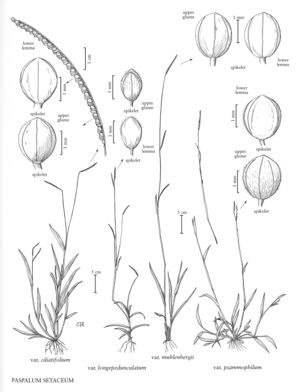Difference between revisions of "Paspalum setaceum var. longepedunculatum"
FNA>Volume Importer |
imported>Volume Importer |
||
| (4 intermediate revisions by 2 users not shown) | |||
| Line 4: | Line 4: | ||
|publications= | |publications= | ||
|common_names=Barestem paspalum | |common_names=Barestem paspalum | ||
| + | |special_status={{Treatment/ID/Special_status | ||
| + | |code=E | ||
| + | |label=Endemic | ||
| + | }} | ||
|basionyms= | |basionyms= | ||
|synonyms={{Treatment/ID/Synonym | |synonyms={{Treatment/ID/Synonym | ||
|name=Paspalum longepedunculatum | |name=Paspalum longepedunculatum | ||
| − | |authority= | + | |authority= |
| + | |rank=species | ||
}} | }} | ||
|hierarchy=Poaceae;Poaceae subfam. Panicoideae;Poaceae tribe Paniceae;Paspalum;Paspalum setaceum;Paspalum setaceum var. longepedunculatum | |hierarchy=Poaceae;Poaceae subfam. Panicoideae;Poaceae tribe Paniceae;Paspalum;Paspalum setaceum;Paspalum setaceum var. longepedunculatum | ||
| Line 19: | Line 24: | ||
-->{{Treatment/Body | -->{{Treatment/Body | ||
| − | |discussion=<p>Paspalum setaceum var. longepedunculatum grows on open ground, usually in moist areas such as along ditches and roadsides, as well as in flatwoods. It is found primarily in the coastal plain of the southeastern United States, but has also been found in Ohio, Kentucky, and Tennessee. It is similar to var. villosissimum, differing in its glabrous leaves, more delicate habit, and more poorly-developed rhizomes. Both varieties grow in peninsular Florida, but var. longepedunculatum also grows along the coast as far west as the Mississippi delta and as far north as southern North Carolina.</p> | + | |discussion=<p><i>Paspalum setaceum </i>var.<i> longepedunculatum</i> grows on open ground, usually in moist areas such as along ditches and roadsides, as well as in flatwoods. It is found primarily in the coastal plain of the southeastern United States, but has also been found in Ohio, Kentucky, and Tennessee. It is similar to <i></i>var.<i> villosissimum</i>, differing in its glabrous leaves, more delicate habit, and more poorly-developed rhizomes. Both varieties grow in peninsular Florida, but <i></i>var.<i> longepedunculatum</i> also grows along the coast as far west as the Mississippi delta and as far north as southern North Carolina.</p> |
|tables= | |tables= | ||
|references= | |references= | ||
| Line 28: | Line 33: | ||
-->{{#Taxon: | -->{{#Taxon: | ||
name=Paspalum setaceum var. longepedunculatum | name=Paspalum setaceum var. longepedunculatum | ||
| − | |||
|authority=(Leconte) Alph. Wood | |authority=(Leconte) Alph. Wood | ||
|rank=variety | |rank=variety | ||
| Line 35: | Line 39: | ||
|basionyms= | |basionyms= | ||
|family=Poaceae | |family=Poaceae | ||
| − | |illustrator=Linda A. Vorobik | + | |illustrator=Linda A. Vorobik;Cindy Roché |
| + | |illustration copyright=Utah State University | ||
|reference=None | |reference=None | ||
|publication title= | |publication title= | ||
|publication year= | |publication year= | ||
| − | |special status= | + | |special status=Endemic |
| − | |source xml=https:// | + | |source xml=https://bitbucket.org/aafc-mbb/fna-data-curation/src/200273ad09963decb8fc72550212de541d86569d/coarse_grained_fna_xml/V25/V25_1476.xml |
|subfamily=Poaceae subfam. Panicoideae | |subfamily=Poaceae subfam. Panicoideae | ||
|tribe=Poaceae tribe Paniceae | |tribe=Poaceae tribe Paniceae | ||
Latest revision as of 17:57, 11 May 2021
Plants erect. Leaves mostly basal; blades to 15 cm long, 3-10 mm wide, glabrous, usually recurved, yellow-green, margins ciliate. Panicle branches 2.4-9.2 cm long, ascending or nodding, arcuate; branch axes 0.2-0.6 mm wide. Spikelets 1.4-1.8 mm long, 0.9-1.3 mm wide, elliptic to obovate or suborbicular, glabrous or with scattered glandular hairs, not spotted; lower lemmas without an evident midvein; upper florets 1.4-1.8 mm.
Discussion
Paspalum setaceum var. longepedunculatum grows on open ground, usually in moist areas such as along ditches and roadsides, as well as in flatwoods. It is found primarily in the coastal plain of the southeastern United States, but has also been found in Ohio, Kentucky, and Tennessee. It is similar to var. villosissimum, differing in its glabrous leaves, more delicate habit, and more poorly-developed rhizomes. Both varieties grow in peninsular Florida, but var. longepedunculatum also grows along the coast as far west as the Mississippi delta and as far north as southern North Carolina.
Selected References
None.
